
Creating Computer vision datasets
How to create a new novel datasets from a few set of images.

import pandas as pd
import numpy as np
import seaborn as sns
import torch
import torch.nn as nn
import torch.nn.functional as F
from torch.utils.data import DataLoader
from torch.utils.data import TensorDataset
import matplotlib.pyplot as plt
from sklearn.model_selection import train_test_split
from sklearn.metrics import accuracy_score, confusion_matrix, classification_report
from sklearn.preprocessing import StandardScaler
# set default figure size
plt.rcParams['figure.figsize'] = (15, 7.0)
heart_data = '../input/heart-attack-analysis-prediction-dataset/heart.csv'
heart_df = pd.read_csv(heart_data)
heart_df.head()
| age | sex | cp | trtbps | chol | fbs | restecg | thalachh | exng | oldpeak | slp | caa | thall | output | |
|---|---|---|---|---|---|---|---|---|---|---|---|---|---|---|
| 0 | 63 | 1 | 3 | 145 | 233 | 1 | 0 | 150 | 0 | 2.3 | 0 | 0 | 1 | 1 |
| 1 | 37 | 1 | 2 | 130 | 250 | 0 | 1 | 187 | 0 | 3.5 | 0 | 0 | 2 | 1 |
| 2 | 41 | 0 | 1 | 130 | 204 | 0 | 0 | 172 | 0 | 1.4 | 2 | 0 | 2 | 1 |
| 3 | 56 | 1 | 1 | 120 | 236 | 0 | 1 | 178 | 0 | 0.8 | 2 | 0 | 2 | 1 |
| 4 | 57 | 0 | 0 | 120 | 354 | 0 | 1 | 163 | 1 | 0.6 | 2 | 0 | 2 | 1 |
# describe the data
heart_df.describe()
| age | sex | cp | trtbps | chol | fbs | restecg | thalachh | exng | oldpeak | slp | caa | thall | output | |
|---|---|---|---|---|---|---|---|---|---|---|---|---|---|---|
| count | 303.000000 | 303.000000 | 303.000000 | 303.000000 | 303.000000 | 303.000000 | 303.000000 | 303.000000 | 303.000000 | 303.000000 | 303.000000 | 303.000000 | 303.000000 | 303.000000 |
| mean | 54.366337 | 0.683168 | 0.966997 | 131.623762 | 246.264026 | 0.148515 | 0.528053 | 149.646865 | 0.326733 | 1.039604 | 1.399340 | 0.729373 | 2.313531 | 0.544554 |
| std | 9.082101 | 0.466011 | 1.032052 | 17.538143 | 51.830751 | 0.356198 | 0.525860 | 22.905161 | 0.469794 | 1.161075 | 0.616226 | 1.022606 | 0.612277 | 0.498835 |
| min | 29.000000 | 0.000000 | 0.000000 | 94.000000 | 126.000000 | 0.000000 | 0.000000 | 71.000000 | 0.000000 | 0.000000 | 0.000000 | 0.000000 | 0.000000 | 0.000000 |
| 25% | 47.500000 | 0.000000 | 0.000000 | 120.000000 | 211.000000 | 0.000000 | 0.000000 | 133.500000 | 0.000000 | 0.000000 | 1.000000 | 0.000000 | 2.000000 | 0.000000 |
| 50% | 55.000000 | 1.000000 | 1.000000 | 130.000000 | 240.000000 | 0.000000 | 1.000000 | 153.000000 | 0.000000 | 0.800000 | 1.000000 | 0.000000 | 2.000000 | 1.000000 |
| 75% | 61.000000 | 1.000000 | 2.000000 | 140.000000 | 274.500000 | 0.000000 | 1.000000 | 166.000000 | 1.000000 | 1.600000 | 2.000000 | 1.000000 | 3.000000 | 1.000000 |
| max | 77.000000 | 1.000000 | 3.000000 | 200.000000 | 564.000000 | 1.000000 | 2.000000 | 202.000000 | 1.000000 | 6.200000 | 2.000000 | 4.000000 | 3.000000 | 1.000000 |
# checking data types
heart_df.dtypes
age int64
sex int64
cp int64
trtbps int64
chol int64
fbs int64
restecg int64
thalachh int64
exng int64
oldpeak float64
slp int64
caa int64
thall int64
output int64
dtype: object
# drop duplicates if any
heart_df.drop_duplicates()
# check missing valus
heart_df.isna().sum()
age 0
sex 0
cp 0
trtbps 0
chol 0
fbs 0
restecg 0
thalachh 0
exng 0
oldpeak 0
slp 0
caa 0
thall 0
output 0
dtype: int64
# check output column class distribution
sns.countplot(x='output', data=heart_df).set_title("output Column Distribution")
Text(0.5, 1.0, 'output Column Distribution')
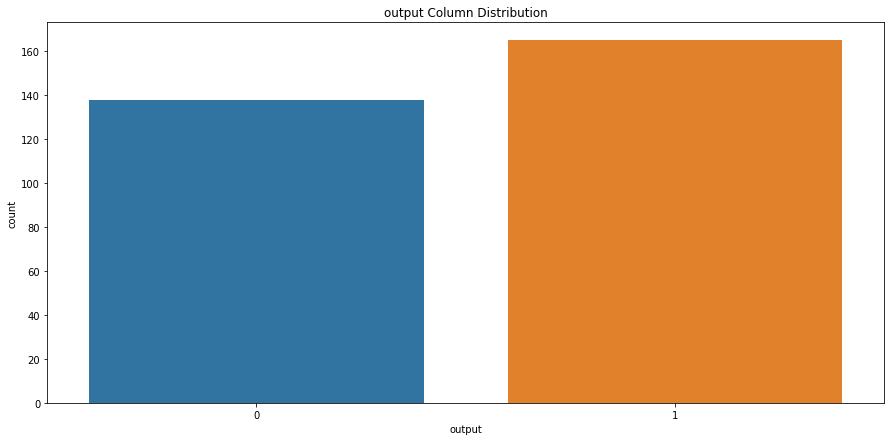
# check sex column class distribution
sns.countplot(x='sex', data=heart_df).set_title("Sex Column Distribution")
Text(0.5, 1.0, 'Sex Column Distribution')

# box plot for output and cholestrol level
sns.boxplot(x="output",y="chol",data=heart_df)
<AxesSubplot:xlabel='output', ylabel='chol'>

# box plot for output and cholestrol level
sns.boxplot(x="output",y="thalachh",data=heart_df)
<AxesSubplot:xlabel='output', ylabel='thalachh'>
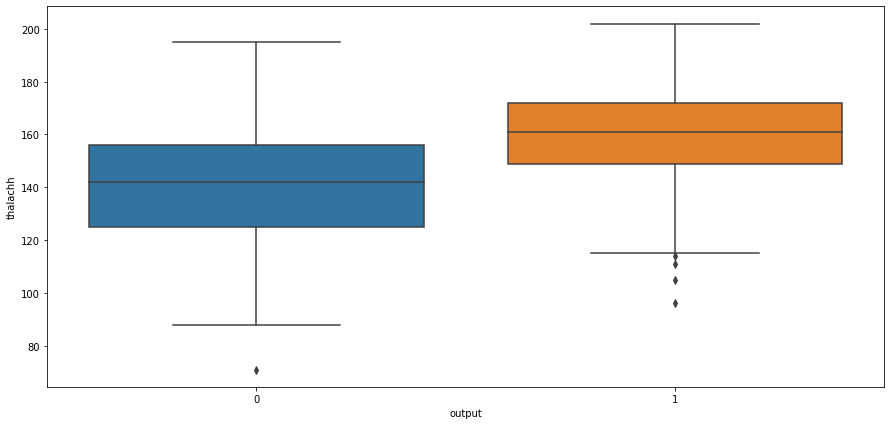
# box plot for output and cholestrol level
sns.boxplot(x="output",y="oldpeak",data=heart_df)
<AxesSubplot:xlabel='output', ylabel='oldpeak'>

# box plot for output and cholestrol level
sns.boxplot(x="output",y="age",data=heart_df)
<AxesSubplot:xlabel='output', ylabel='age'>

ax = sns.countplot(x='age', data=heart_df)
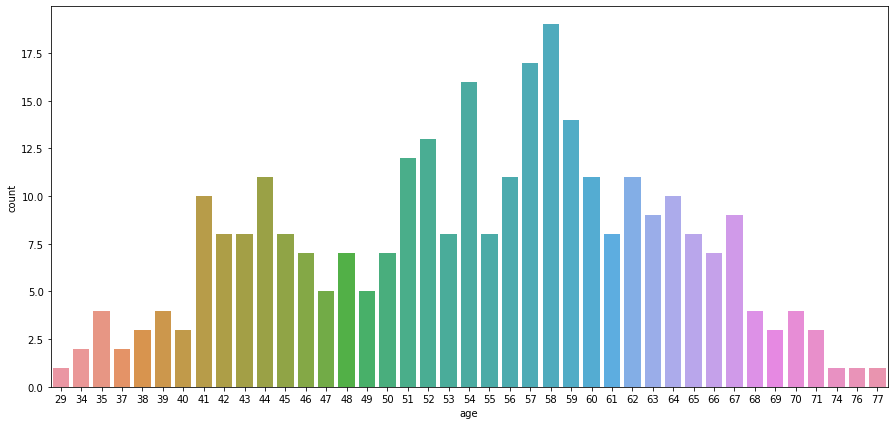
# check correlation
corr = heart_df.corr()
# Generate a mask for the upper triangle
mask = np.triu(np.ones_like(corr, dtype=bool))
# Set up the matplotlib figure
f, ax = plt.subplots(figsize=(11, 9))
# Generate a custom diverging colormap
cmap = sns.diverging_palette(230, 20, as_cmap=True)
# Draw the heatmap with the mask and correct aspect ratio
sns.heatmap(corr, mask=mask, cmap=cmap, vmax=.3, center=0,
square=True, linewidths=.5, cbar_kws={"shrink": .5}).set_title("Columns Correlation")
Text(0.5, 1.0, 'Columns Correlation')
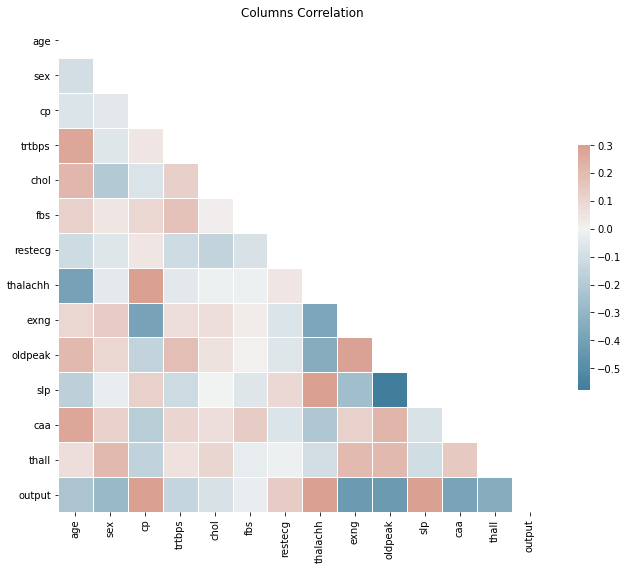
# split data for training
y = heart_df.output.to_numpy()
X = heart_df.drop('output', axis=1).to_numpy()
# scale X values
scaler = StandardScaler()
X = scaler.fit_transform(X)
# split data while keeping output class distribution consistent
X_train, X_test, y_train, y_test = train_test_split(X, y, test_size=0.2, stratify=y)
# convert data to pytorch tensors
def df_to_tensor(df):
return torch.from_numpy(df).float()
X_traint = df_to_tensor(X_train)
y_traint = df_to_tensor(y_train)
X_testt = df_to_tensor(X_test)
y_testt = df_to_tensor(y_test)
# create pytorch dataset
train_ds = TensorDataset(X_traint, y_traint)
test_ds = TensorDataset(X_testt, y_testt)
# create data loaders
batch_size = 5
train_dl = DataLoader(train_ds, batch_size, shuffle=True)
test_dl = DataLoader(test_ds, batch_size, shuffle=False)
# model architecture
class BinaryNetwork(nn.Module):
def __init__(self, input_size, output_size):
super().__init__()
self.l1 = nn.Linear(input_size, 64)
self.l2 = nn.Linear(64, 32)
self.l3 = nn.Linear(32, 16)
self.out = nn.Linear(16, output_size)
def forward(self, x):
x = self.l1(x)
x = F.relu(x)
x = self.l2(x)
x = F.relu(x)
x = self.l3(x)
x = F.relu(x)
x = self.out(x)
return torch.sigmoid(x) # scaling values between 0 and 1
input_size = 13 # number of features
output_size = 1
model = BinaryNetwork(input_size, output_size)
loss_fn = nn.BCELoss() # Binary Cross Entropy
optim = torch.optim.Adam(model.parameters(), lr=1e-3)
model
BinaryNetwork(
(l1): Linear(in_features=13, out_features=64, bias=True)
(l2): Linear(in_features=64, out_features=32, bias=True)
(l3): Linear(in_features=32, out_features=16, bias=True)
(out): Linear(in_features=16, out_features=1, bias=True)
)
epochs = 100
losses = []
for i in range(epochs):
epoch_loss = 0
for feat, target in train_dl:
optim.zero_grad()
out = model(feat)
loss = loss_fn(out, target.unsqueeze(1))
epoch_loss += loss.item()
loss.backward()
optim.step()
losses.append(epoch_loss)
# print loss every 10
if i % 10 == 0:
print(f"Epoch: {i}/{epochs}, Loss = {loss:.5f}")
Epoch: 0/100, Loss = 0.79641
Epoch: 10/100, Loss = 0.03637
Epoch: 20/100, Loss = 0.07704
Epoch: 30/100, Loss = 0.02023
Epoch: 40/100, Loss = 0.00084
Epoch: 50/100, Loss = 0.00000
Epoch: 60/100, Loss = 0.00001
Epoch: 70/100, Loss = 0.00000
Epoch: 80/100, Loss = 0.00018
Epoch: 90/100, Loss = 0.00029
# plot losses
graph = sns.lineplot(x=[x for x in range(0, epochs)], y=losses)
graph.set(title="Loss change during training", xlabel='epochs', ylabel='loss')
plt.show()
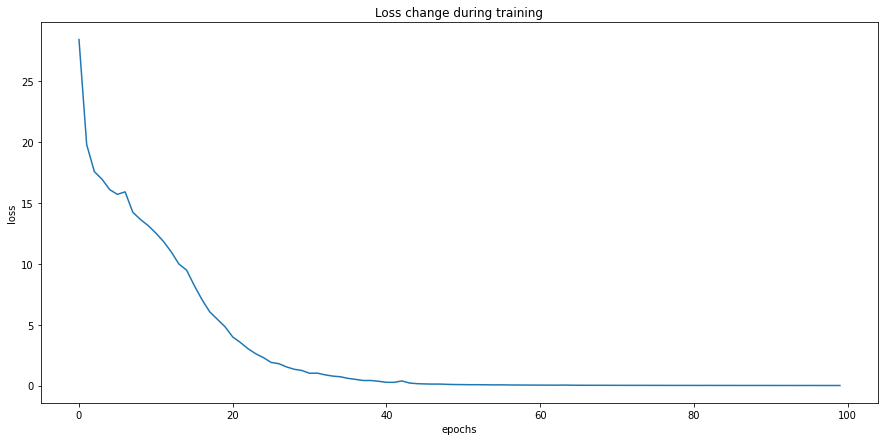
# evaluate the model
y_pred_list = []
model.eval()
with torch.no_grad():
for X, y in test_dl:
y_test_pred = model(X)
y_pred_tag = torch.round(y_test_pred)
y_pred_list.append(y_pred_tag)
# convert predictions to a list of tensors with 1 dimention
y_pred_list = [a.squeeze() for a in y_pred_list]
# check confusion matrix (hstack will merge all tensor lists into one list)
cfm = confusion_matrix(y_test, torch.hstack(y_pred_list))
sns.heatmap(cfm / np.sum(cfm), annot=True, fmt='.2%')
<AxesSubplot:>
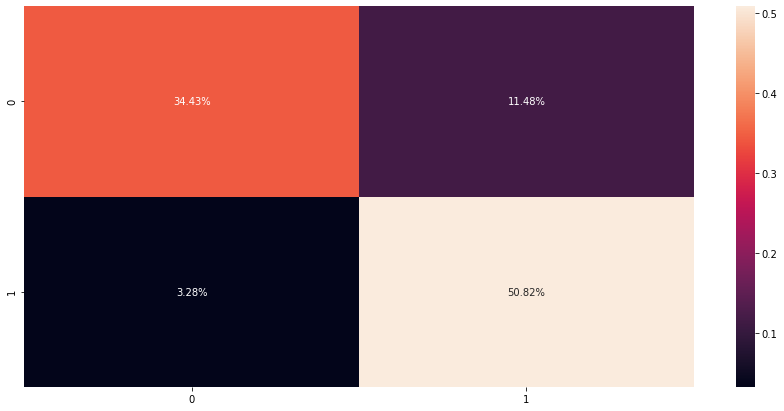
# print metrics
print(classification_report(y_test, torch.hstack(y_pred_list)))
precision recall f1-score support
0 0.91 0.75 0.82 28
1 0.82 0.94 0.87 33
accuracy 0.85 61
macro avg 0.86 0.84 0.85 61
weighted avg 0.86 0.85 0.85 61

How to create a new novel datasets from a few set of images.

Data Science Project

Data Science Project

A Decentralized Application that simulates a bank using blockchain